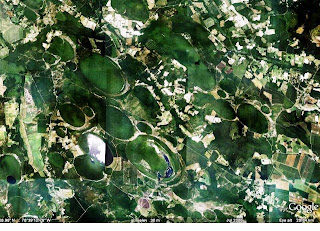Well, you may be strolling over the treasure since no one knows where Blackbeard hid the stash. But I'm talking about a Carolina Bay.
Acre(s)-large, mostly elliptical, and predominantly situated northwest/southeast, Carolina Bays exist by the thousands below the Mason Dixon line and can be seen on aerial photos and satellite shots such as this Google Earth image:
 Carolina Bays Have Made An Impression on Bladen County, NC
Carolina Bays Have Made An Impression on Bladen County, NC
Named after the sweet-, red-, and loblolly bay trees that often grow in the sandy rims around these indentions, most bays are unnoticeable in everyday life unless you live in Bladen County, NC, which is home to nearly a thousand of them, or if you travel to Lake Waccamaw, the largest Carolina Bay in NC.
These geological marvels are a mystery to me, so I can't begin to explain the theories of their origin, common elements among bays, soil make up, efforts to restore them, etc. If you can't stand the not-knowing, I've provided several links to helpful resources at the bottom of this page. Hop on down there or stick around while I finally get to the subject of this post... Lake Waccamaw State Park is located in southeast NC, southeast(ish) of Lumberton and west of Wilmington. Finding it is easy if you're not using a GPS. Our dear device tried to send us over dirt and gravel paths instead of perfectly acceptable paved roads. So if you're heading to Lake Waccamaw, compare your GPS's suggested route to an atlas, and follow the atlas if need be. If you don't have a GPS, North Carolina has provided excellent directions on their Lake Waccamaw State Park site at www.ncparks.gov/Visit/parks/lawa/directions.php
Lake Waccamaw State Park is located in southeast NC, southeast(ish) of Lumberton and west of Wilmington. Finding it is easy if you're not using a GPS. Our dear device tried to send us over dirt and gravel paths instead of perfectly acceptable paved roads. So if you're heading to Lake Waccamaw, compare your GPS's suggested route to an atlas, and follow the atlas if need be. If you don't have a GPS, North Carolina has provided excellent directions on their Lake Waccamaw State Park site at www.ncparks.gov/Visit/parks/lawa/directions.php
This attractive park offers the usual array of activities: picnicking, camping, fishing, and--to our immense pleasure--hiking. During this visit, we hiked at least four miles of the park's nine or so mile trail system, traversing primarily on sandy soil alongside the lake, under tattered Spanish moss. We stopped at the park's 375-foot pier, enjoyed the view, and then followed the Pine Woods Trail back to the Visitor's Center, where one can freshen up in clean restrooms.

Boating is an option as well, but ramps aren't available in the park. However, public access ramps are located nearby. NC Parks recommends contacting the Wildlife Resource Commission for more information.
In addition to the serene beauty and the knowledge of walking alongside a mysterious Carolina Bay, visitors to Lake Waccamaw may see wildlife including birds and alligators--seriously--and plantlife. Home to ancient cypress trees, the lake is at the edge of the biological preserve, Green Swamp. That in itself indicates botanical wonders, but the water holds another secret.
Bodies of water that originate in the coastal plains are black and acidic thanks to ubiquitous cypress trees. From my new acquisition, The Natural Traveler: Along North Carolina's Coast, we learned a limestone outcropping along the northern shore gives the waters of Lake Waccamaw a near neutral pH. As a result, unusual aquatic and plant life exist in this area, the latter of which may be visible along the trail. That new fact calls for more research--and a return trip with fellow CarolinasAdventurers.
For more information on Lake Waccamaw's unique ecology, visit http://www.ncparks.gov/Visit/parks/lawa/ecology.php
As usual with the waters of the coast, the recommended method of exploring is by kayak or canoe. So if you have either, take a trip to Lake Waccamaw and, as The Natural Traveler recommends, consider exploring the Waccamaw River while you're there. We've yet to venture into either method of water exploration, but soon. Very soon.
Below is a slideshow of a few pictures we took on this trip. No show-stoppers, but it's a decent journal of what we saw. For more information on Lake Waccamaw and the Carolina Bays, check out the links at the end of this post.
Lake Waccamaw
http://org.elon.edu/geo/waccamaw.htm
Carolina Bays
www.fws.gov/seweecenter/text/carolinabays.pdf
www.ces.clemson.edu/scmaps/manual/pdfmanual/chap8.pdf
Nature Conservancy Carolina Bay Preserves
Bay Images:
http://abob.libs.uga.edu/bobk/cbaymbm.jpg
http://www.ces.clemson.edu/semaps/nc/cbay.html
http://abob.libs.uga.edu/bobk/cbaymbsc.html

No comments:
Post a Comment